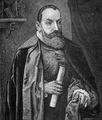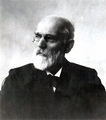Template:Selected anniversaries/August 22: Difference between revisions
No edit summary |
No edit summary |
||
| Line 8: | Line 8: | ||
||1751: Andrew Gordon dies ... Benedictine monk, physicist and inventor. He made the first electric motor. Pic: https://www.beatson.co.uk/history-electric-motors/ | ||1751: Andrew Gordon dies ... Benedictine monk, physicist and inventor. He made the first electric motor. Pic: https://www.beatson.co.uk/history-electric-motors/ | ||
||1752: William Whiston dies ... mathematician, historian, and theologian. | ||1752: William Whiston dies ... mathematician, historian, and theologian. Pic. | ||
||1771: Henry Maudslay born ... engineer. | ||1771: Henry Maudslay born ... engineer. Pic. | ||
||1787: Inventor John Fitch demonstrated his steamboat on the Delaware River to delegates of the Continental Congress. Its top speed was 3 mph. These tests were completed years before Fulton built his steamboat. Early in 1787, the Colombian Magazine described the steam engine design as “similar to the late improved steam engines in Europe,” with a horizontal twelve-inch cylinder. The piston was proposed to give “thirty strokes in a minute; which will give the axle tree about forty revolutions. Each revolution of the axle tree moves twelve oars five and a half feet. As six oars come out of the water, six more enter the water... The oars work perpendicularly and make a stroke similar to the paddle of a canoe.” | ||1787: Inventor John Fitch demonstrated his steamboat on the Delaware River to delegates of the Continental Congress. Its top speed was 3 mph. These tests were completed years before Fulton built his steamboat. Early in 1787, the Colombian Magazine described the steam engine design as “similar to the late improved steam engines in Europe,” with a horizontal twelve-inch cylinder. The piston was proposed to give “thirty strokes in a minute; which will give the axle tree about forty revolutions. Each revolution of the axle tree moves twelve oars five and a half feet. As six oars come out of the water, six more enter the water... The oars work perpendicularly and make a stroke similar to the paddle of a canoe.” | ||
Revision as of 21:38, 23 May 2019
1647: Physicist, mathematician, and inventor Denis Papin born. He will invent the steam digester, the forerunner of the pressure cooker and of the steam engine.
1854: Poet Jan Kochanowski dies. He established poetic patterns which would become integral to the Polish literary language.
1919: Theoretical physicist and crime-fighter Johannes Diderik van der Waals publishes new class of Gnomon algorithm functions which detect and prevent crimes against mathematical constants based on the states of gases and liquids.
1920: Science fiction writer and screenwriter Ray Bradbury born. The New York Times will call Bradbury "the writer most responsible for bringing modern science fiction into the literary mainstream".
1943: Signed first edition of Janet Beta at ENIAC traded for freshly minted 1943 Eleanor Roosevelt dime.
1974: Mathematician, historian of science, theatre author, poet, and inventor Jacob Bronowski dies.





